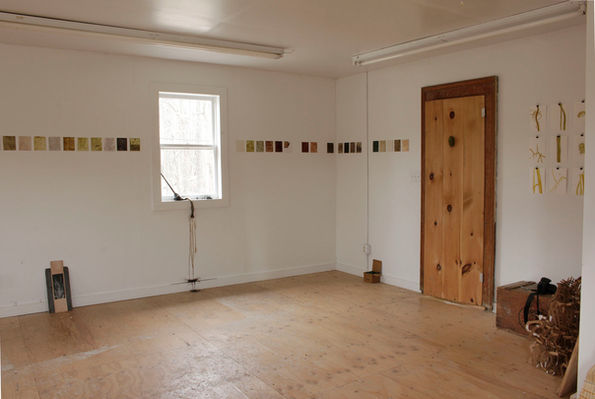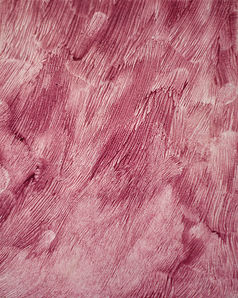Klara-Marié
den Heijer
RESIDENCY 108, NEW YORK STATE, USA
'SHADES OF LANDSCAPE'
As an oil painter I am interested in the convention of landscape painting. The genre of landscape painting often relates to questions of ownership or - in the context of my work – feelings of belonging. Landscape is a medium that frames people as belonging to the land, and the land as owned by people. Thus landscape hints at our yearning to be a part of our surroundings, while simultaneously revealing a desire to be different and to stand apart from it. Landscape painting is an act of reflection that touches on this complicated relationship.
During my stay at Residency 108, I looked at how my relationship with this unfamiliar stretch of land developed over the duration of a month. Being situated within the humid continental region of Northeastern United States, the farm covers a mix of deciduous forests, evergreen woodlands, shrublands, meadows, swamps and a couple of ponds in addition to cultivated land (1). In autumn, the season in which I was there, the area undergoes a striking transition: leaves change colour and fall from the trees, daylight becomes shorter and temperatures drop. Being new to all of this, I documented the process of transformation that takes place within the land - and within myself - over this time.

The attic of the residency’s garage was given to me as a studio, a perfect hide-out in which I could let my mind wander. The studio became a metaphor for a mental space where my thoughts could develop on a tactile level (2). Art historian James Elkins describes the artist’s studio as a place of isolation – a solitary prison of total immersion and obsession where one loses touch with reality (3). For me the studio became a place of both refuge and prospects (4). The walls provide a safe space in which to reflect and process experiences, while the windows offer a view into the world and invite me to go out and explore.
I explored the meadows, crawled through the forest undergrowth, followed the low stone walls and often scuffled with creepers while I plucked berries, stripped leaves and dug out roots. I would carefully scrape lichen of the fences and scoop mud from the ponds. Often I headed back to the studio with pockets full of acorns or walnut husks, eager to identify my latest finds.

In time the studio became cluttered with an accumulation of objects, materials and substances. To keep track, I categorised them on the floor - using old roof tiles as a grid. My collection included dockweed roots, bittersweet berries, sumac spears, pokeweed berries, egg shells, toadflax flowers, Chinese privet, a red brick, rotten wood and mullein leaves. Some strange objects made themselves at home: a cranky funnel, a small tea sieve, a stainless steel saucepan (pulled from the muck of the forest floor), soiled glass bottles (sourced from a previous landowner’s dumpsite), plastic containers from the recycle bin, a turkey baster (something like a glorified eyedropper), some promising wire mesh, square tiles repurposed as palettes, coffee filters and trespassing flies.
A series of experiments followed. The studio table became the site of transformation. I crushed plant matter, mixed solutions and initiated fizzy reactions in hope of colourful deposits. I kept a watchful eye over precipitates settling, filters dripping (clogged with dregs) and sediments drying. After which the residue was ground and mulled into my own hand-made paint, my materia prima (5).

What emerged was a series of 108 tablets. Each tablet (12 cm x 8 cm) was painted with pigments extracted from the 108 acres of land on the farm. Shades of landscape. Pinned up on the wall at eye level they formed along line of colour swatches that ran all around the studio. Like a border they marked the edges of my mental space. They formed a display of my moods, thoughts and interaction with the landscape at Residency 108.
Before I left the residency, I wrapped and packed my tablets in a folder. I carried them back to South Africa as abstractions. Their fugitive colours are now slowly fading, yet they are part of the residue of a place that stuck to me.
FOOTNOTES:
1 New York State’s climate and vegetation are very different from that of my home country. South Africa has a semi-arid climate; it is much drier and warmer.
2 This idea draws from Anselm Kiefer’s view of his studio as written by Mark Rosenthal in his book Anselm Kiefer (1987:22).
3 As Elkins explains in his book What Painting Is (1999:145, 156).
4 Jay Appleton developed a theory around prospect and refuge in The Experience of Landscape (1975).
5 Elkins describes the materia prima as the raw material that the alchemists and painters use to start their transformative processes with. Any ‘inchoate mass’ can be the substance from which form emerges (Elkins 1999:80). Elkins writes that materia prima is ‘both nothing (nothing yet, nothing that has been formed) and everything (everything in potentia, all the things that wait to exist)’ (1999:84).
SOURCES:
Appleton, J. 1975. The Experience of Landscape. New York: John Wiley & Sons.
Elkins, J. 1999. What painting is. New York: Routledge.
Rosenthal, M. 1987. Anselm Kiefer. Chicago: The art institute of Chicago.





































